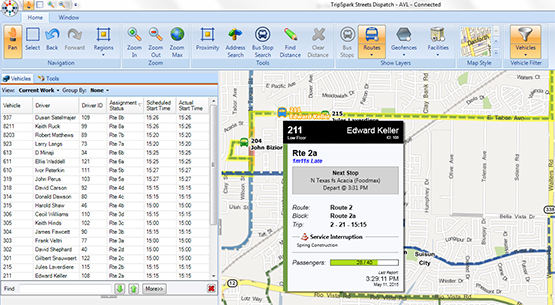CAD/AVL Systems Provide Main Source of Data
The CAD/AVL system (Computer-Aided Dispatch / Automatic Vehicle Location) connects your vehicles seamlessly with your back office scheduling and dispatching software. It automatically collects vital data used by dispatchers such as bus GPS locations, schedule adherence status, breakdowns and emergencies. It also integrates with your system to pass essential information to in-vehicle peripherals (headsigns, annunciators, etc.) and passenger information systems (website and mobile applications.) With real time data, call takers can quickly and accurately respond to ‘Where’s my bus?’ calls. Dispatchers have greater insight and control over their buses and can quickly assign vehicles to routes based upon any number of criteria.
The Power of Computer-aided Dispatch
TripSpark’s CAD allows dispatchers to easily create assignments and track event information ranging from schedule and route deviations to excessive speeding or idling, accidents and driver emergencies.
- Quickly look up driver schedules
- Track the roadworthy status of every vehicle
- Send both canned and custom text messages to drivers
- Electronically store event information
The Insight of Automatic Vehicle Location
Your dispatcher will be able to see the current, exact location of your buses on a computer map. When the buses move, the icons that represent the buses move, too. Your in-vehicle technology provides real time GPS updates regarding:
- If a bus is early or late
- If a bus is off its assigned route
- Historical schedule adherence information
- Speed and direction the bus travels
Easily Manage Driver Assignments & Events
If an employee can’t fill a shift, his or her work can be reassigned, split, or canceled. As buses drive their routes, dispatchers can easily monitor buses that don’t adhere to schedules or buses that drive off-route, which is then labeled “event”.
- Track events in a color-coded list based on priority
- View event details or event logs
- Assign events to be dealt with by specific employees

Fixed Route CAD/AVL: Keeping Buses in the Loop
In-vehicle technology connects vehicles with the office in real time in order to provide updates to schedulers, dispatchers, managers and riders. The ruggedized Ranger, in-vehicle mobile computer is the main terminal, specifically designed to withstand the harsh transit environment. Unlike a personal tablet, the Ranger is water-proof, shock resistant and virtually indestructible. It is designed solely to maintain communication and fully integrate with vehicle systems, such as:
- Fareboxes
- Annunciators
- Automatic traveler counters
- Headsign integration
- Automated fare collectors

